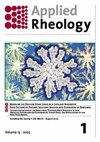Assessment of the usability conditions of Sb2O3–PbO–B2O3 glasses for shielding purposes in some medical radioisotope and a wide gamma-ray energy spectrum
IF 1.8
4区 工程技术
Q1 MECHANICS
引用次数: 21
Abstract
Abstract We report some fundamental gamma-ray shielding properties and individual transmission factors (TFs) of five distinct glass samples with a nominal composition of xSb2O3·(40 − x)PbO·60B2O3·0.5CuO and (where; 0 ≤ x ≤ 40 mol%). Phy-X/PSD and MCNPX (version 2.7.0) Monte Carlo code are utilized to determine several critical parameters, such as cross-sections, attenuation coefficients, half and tenth value layers, build-up factors, and TFs. A general transmission setup is designed using basic requirements. Accordingly, TFs are evaluated for several medical radioisotopes. Next, the gamma-ray shielding parameters and TFs are assessed together in terms of providing the validity of the findings. Our results showed that there is a positive contribution of increasing Sb2O3 amount in the glass matrix owing its direct effect to the density increment as well. This positive effect on gamma-ray shielding properties is also observed for decreasing mean free path values from S1 to S5 samples. The exposure build-up factor (EBF) and energy absorption build-up factor (EABF) values, increasing the quantity of Sb2O3 supplementation, resulted in a general reduction in EBF and EABF values (i.e., from 0.5 to 40 mfp). When the quantity of Sb2O3 rises from S1 to S5, the collision rate of incoming gamma rays in glass samples increases significantly. The TF figures reveal that S5 showed the least transmission behavior across all the above-mentioned studied glass thicknesses. It can be concluded that increasing the Sb2O3 additive is a beneficial and monotonic technique, when the gamma-ray shielding qualities or TF values must be further enhanced.Sb2O3-PbO-B2O3玻璃屏蔽某些医用放射性同位素和宽伽玛射线能谱的可用性条件评估
摘要:本文报道了五种不同玻璃样品的一些基本的伽马射线屏蔽性能和单个透射系数(TFs),其标称成分为xSb2O3·(40−x)PbO·60B2O3·0.5CuO和(其中;0≤x≤40 mol%)。Phy-X/PSD和MCNPX(2.7.0版本)蒙特卡罗代码用于确定几个关键参数,如横截面,衰减系数,一半和十分值层,累积因子和TFs。一般的传动装置是根据基本要求设计的。因此,评估了几种医用放射性同位素的TFs。接下来,伽马射线屏蔽参数和tf一起评估,以提供研究结果的有效性。结果表明,玻璃基体中Sb2O3含量的增加对密度的增加也有直接的影响。从S1到S5样品的平均自由程值的减少也观察到这种对伽马射线屏蔽性能的积极影响。暴露累积因子(EBF)和能量吸收累积因子(EABF)值增加了Sb2O3的补充量,导致EBF和EABF值普遍降低(即从0.5 mfp降至40 mfp)。当Sb2O3的含量从S1增加到S5时,玻璃样品中入射伽马射线的碰撞率显著增加。TF图显示,S5在所有上述研究的玻璃厚度中表现出最小的透射行为。结果表明,当γ射线屏蔽性能或TF值需要进一步提高时,增加Sb2O3的添加量是一种有益的单调技术。
本文章由计算机程序翻译,如有差异,请以英文原文为准。
求助全文
约1分钟内获得全文
求助全文
来源期刊

Applied Rheology
物理-力学
CiteScore
3.00
自引率
5.60%
发文量
7
审稿时长
>12 weeks
期刊介绍:
Applied Rheology is a peer-reviewed, open access, electronic journal devoted to the publication in the field of applied rheology. The journal provides the readers with free, instant, and permanent access to all content worldwide; and the authors with extensive promotion of published articles, long-time preservation, language-correction services, no space constraints and immediate publication.
 求助内容:
求助内容: 应助结果提醒方式:
应助结果提醒方式:


